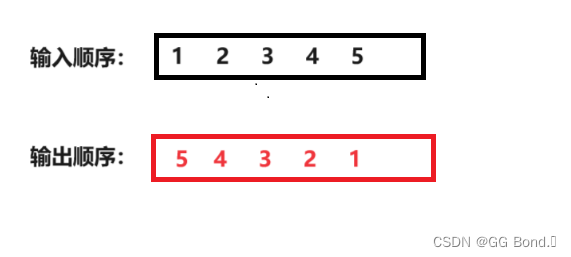前言:
在学习完数据结构顺序表和链表之后,其实我们就可以做很多事情了,后面的栈和队列,其实就是对前面的顺序表和链表的灵活运用,今天我们就来学习一下栈的原理和应用。
准备工作:本人习惯将文件放在test.c、SeqList.c、SeqList.h三个文件中来实现,其中test.c用来放主函数,SeqList.c用来放调用的函数,SeqList.h用来放头文件和函数声明
目录
什么是队列?
队列中的数据是按照先进后出的顺序的,也就是说先进去的数字后出来

因为栈的这种性质,所以栈我们用顺序表来实现比链表方便很多,顺序表就可以实现尾插尾出,所以我们一般就采用顺序表来实现
栈的节点结构
队列采用的顺序表的结构,所以与顺序表差异不大
typedef int STDataType;
typedef struct stack
{
STDataType* a;
int top; //指向栈元素下一位
int capacity;
}ST;
栈的结构很简单,定义一个整形指针,一个表示容量和一个表示尾部元素的整形变量即可
栈的基本操作
//初始化
void STInit(ST* pst);
//销毁
void STDestroy(ST* pst);
//插入元素
void STPush(ST* pst, STDataType x);
//删除元素
void STPop(ST* pst);
//判断栈顶元素是否为空
bool STEmpty(ST* pst);
//找栈顶元素
STDataType STTop(ST* pst);
//栈中元素个数
STDataType STSize(ST* pst);看上面的函数声明部分我们就可以看到我们每一步要实现的内容,接下来,我们就来一步一步进行实现
1、初始化
//初始化
void STInit(ST* pst)
{
pst->a = NULL;
pst->capacity = 0;
pst->top = 0;
}
2、销毁
//销毁
void STDestroy(ST* pst)
{
assert(pst);
free(pst->a);
pst->capacity = pst->top = 0;
}
3、插入元素
插入元素时要先检查空间是否够用,如果不够用要先进行扩容
//插入元素
void STPush(ST* pst, STDataType x)
{
if (pst->top == pst->capacity)
{
int newcapacity = pst->capacity == 0 ? 4 : pst->capacity * 2;
STDataType* newnode = (STDataType*)realloc(pst->a, sizeof(STDataType) * newcapacity);
if (newnode == NULL)
{
perror("STPush");
return;
}
pst->a = newnode;
pst->capacity = newcapacity;
}
pst->a[pst->top] = x;
pst->top++;
}
4、判断栈顶元素是否为空
这一步在下面有用到,例如当删除栈顶元素时,如果栈顶元素为空就无法操作,所以需要判断栈顶元素是否为空
//判断栈顶元素是否为空
bool STEmpty(ST* pst)
{
assert(pst);
return pst->top == 0;
}
5、删除元素
这里删除元素是删除栈顶元素,因为栈的特性是即出即删
//删除元素
void STPop(ST* pst)
{
assert(pst);
assert(!STEmpty(pst));
pst->top--;
}
6、返回栈顶元素
//找栈顶元素
STDataType STTop(ST* pst)
{
assert(pst);
assert(!STEmpty(pst));
return pst->a[pst->top - 1];
}
7、栈中元素个数
//栈中元素个数
STDataType STSize(ST* pst)
{
assert(pst);
return pst->capacity;
}完整的栈实例
SeqList.h
//实现栈
typedef int STDataType;
typedef struct stack
{
STDataType* a;
int top; //指向栈元素下一位
int capacity;
}ST;
//初始化
void STInit(ST* pst);
//销毁
void STDestroy(ST* pst);
//插入元素
void STPush(ST* pst, STDataType x);
//删除元素
void STPop(ST* pst);
//判断栈顶元素是否为空
bool STEmpty(ST* pst);
//找栈顶元素
STDataType STTop(ST* pst);
//栈中元素个数
STDataType STSize(ST* pst);test.c
//实现栈
void test()
{
ST st;
STInit(&st);
STPush(&st,1);
STPush(&st, 2);
STPush(&st, 3);
STPush(&st, 4);
while (!STEmpty(&st))
{
printf("%d ", STTop(&st));
STPop(&st);
}
STDestroy(&st);
}
int main()
{
test();
return 0;
}SeqList.c
//实现栈
//初始化
void STInit(ST* pst)
{
pst->a = NULL;
pst->capacity = 0;
pst->top = 0;
}
//销毁
void STDestroy(ST* pst)
{
assert(pst);
free(pst->a);
pst->capacity = pst->top = 0;
}
//插入元素
void STPush(ST* pst, STDataType x)
{
if (pst->top == pst->capacity)
{
int newcapacity = pst->capacity == 0 ? 4 : pst->capacity * 2;
STDataType* newnode = (STDataType*)realloc(pst->a, sizeof(STDataType) * newcapacity);
if (newnode == NULL)
{
perror("STPush");
return;
}
pst->a = newnode;
pst->capacity = newcapacity;
}
pst->a[pst->top] = x;
pst->top++;
}
//判断栈顶元素是否为空
bool STEmpty(ST* pst)
{
assert(pst);
return pst->top == 0;
}
//删除元素
void STPop(ST* pst)
{
assert(pst);
assert(!STEmpty(pst));
pst->top--;
}
//找栈顶元素
STDataType STTop(ST* pst)
{
assert(pst);
assert(!STEmpty(pst));
return pst->a[pst->top - 1];
}
//栈中元素个数
STDataType STSize(ST* pst)
{
assert(pst);
return pst->capacity;
}总结
总之,其实栈就是对顺序表的应用,熟练栈和队列,对我们巩固顺序表和链表帮助很大,当然,栈在一些场景下很实用,后面我会出一个专门的习题讲解篇章,讲数据结构的一些经典题型,感兴趣的可以点赞关注一下
创作不易,还请各位大佬点赞支持一下!!!




















 7万+
7万+











 被折叠的 条评论
为什么被折叠?
被折叠的 条评论
为什么被折叠?








